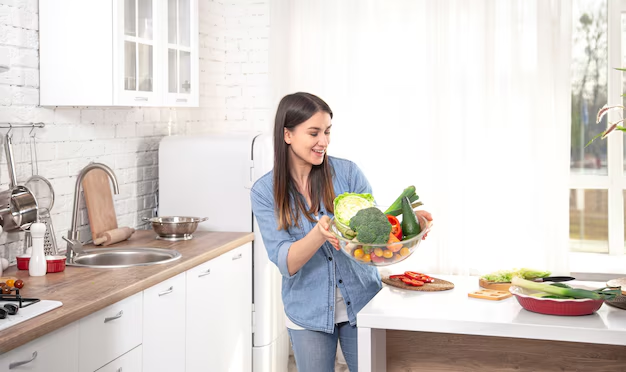How to Keep Your Salad Fresh and Crisp in the Refrigerator 🥗
Salads are a cornerstone of healthy eating, offering nutrition-packed goodness with every bite. Whether you prefer a classic Caesar or a brightly colored Mediterranean mix, there's nothing quite like diving into a fresh salad. However, salads can quickly lose their crispness, becoming soggy and unappetizing if not stored properly. So, what can you do to keep your salad fresh in the refrigerator? Let’s explore some practical, easy-to-follow strategies.
Understanding the Enemies of Salad Freshness
Before diving into the tips, it’s crucial to understand what components contribute to the deterioration of your salad. The primary enemies include moisture, air, and temperature fluctuations.
Moisture: The Sogginess Culprit
Moisture accumulation is a leading cause of soggy salads. Fresh green leaves, while healthy, contain a lot of water. When stored improperly, this moisture condenses, resulting in a limp texture.
Air: The Oxidation Factor
Exposure to air leads to oxidation, which can cause wilting and spoilage. It’s vital to minimize air exposure to preserve freshness and nutritional value.
Temperature Fluctuations: The Freshness Killer
Sudden changes in temperature can damage cell structures in the vegetables, leading them to spoil faster. Consistent refrigeration at the right temperature extends the lifespan of your salad.
Steps to Store Salad Perfectly
Keeping salad fresh starts right from the moment you're organizing it for storage. Here’s a step-by-step guide:
Step 1: Wash and Dry Thoroughly 🌿
Thoroughly washing your greens is essential to remove any potential pesticides or dirt. However, avoid storing wet leaves. Utilize a salad spinner or lay greens on a clean towel to pat them dry. Dry leaves are less likely to spoil quickly.
Step 2: Keep Ingredients Separate
When preparing salads with multiple ingredients like veggies, proteins, and dressings, store them separately. Leafy greens, roasted nuts, and fresh fruits like tomatoes or cucumbers all have different moisture content. Keeping them apart prevents moisture from ingredients like tomatoes from wilting the greens.
Step 3: Use Proper Containers 🥬
Invest in airtight containers or reusable produce bags. Glass or plastic containers with airtight seals reduce exposure to air, keeping your salad crisper longer. Avoid cramped spaces; too much pressure can bruise delicate leaves.
Pro Tips to Enhance Salad Longevity
Utilize Paper Towels
Placing a paper towel in the storage container can absorb excess moisture. Change it every few days, especially if visible moisture accumulates.
Include a Breathable Vent
Some refrigerators come with vegetable drawers equipped with humidity controls. Optimizing these settings can enhance your salad’s freshness by maintaining the ideal environment.
Dressing Protocol 🥗
Keep salads undressed until serving time. Storing salad with dressing can lead to wilting as acids break down the leaves. For mixed salads, carry the dressing separately in small containers until ready to eat.
Techniques for Specific Salad Types
Leafy Green Salads
For leafy greens like romaine, spinach, or kale, chop and rinse thoroughly. Dry them well and store in an airtight container with a paper towel to absorb any lingering moisture.
Pre-Mixed Salads
Many pre-mixed salads come in resealable bags. Once opened, transfer the contents to an airtight container with a paper towel to keep them fresh longer.
Salads with Fruits
For fruit salads, consider fruits with low moisture content such as blueberries and apples. Adding acidic juices like lemon can help slow oxidation and maintain color.
Innovative Storage Hacks
The Jar Method
Layering salad ingredients in a jar minimizes air exposure. Start with the dressing at the bottom, followed by hard veggies like carrots, and finish with greens on top which will prevent them from becoming soggy.
The Vacuum Sealer
If you have one, a vacuum sealer can extend the life of your greens significantly by removing air from the storage bags.
Easy, Scannable Salad Storage Tips
🥬 Quick Tips for Keeping Salad Fresh:
- Avoid Wet Greens: Use a salad spinner and paper towels.
- Separate Ingredients: Store tricky components separately to maintain texture.
- Use Airtight Containers: Seal out air to slow oxidation and spoilage.
- Paper Towels Are Allies: Wipe away excess moisture.
- Don’t Pre-Dress: Store dressings separately to avoid wilting.
Tips for Extending Salad Shelf Life
Understand the Optimal Shelf Life
Knowing how long each ingredient lasts in the fridge can aid in planning:
- Leafy Greens: Typically last 5-7 days when stored correctly.
- Chopped Veggies: Usually remain fresh for up to a week.
- Dressing: Most dressings can last a few weeks, except for homemade variants with fresh ingredients.
Embrace Frequent Rotation
Salads that require storage for prolonged periods benefit from regular inspections. Remove any wilted leaves or moldy pieces immediately to prevent them from affecting the rest of the batch.
Utilize Freezer for Overripe Options
If you notice veggies or fruits nearing the end of their freshness, consider freezing them. While the texture may change, they become excellent for smoothies or cooked dishes.
A Balanced Approach to Salad Storage
By understanding the intricacies of salad storage, maintaining freshness becomes an easy, achievable goal. Investing time upfront in meticulous preparation reaps tasteful and nutritious rewards throughout the week.
Whether you're prepping salads for daily lunches or planning a week-long feast of fresh greens, these strategies empower you to savor every bite without the worry of wilted leaves and soggy veggies. Next time you reach into the refrigerator, rest assured your salad awaits you crisp, fresh, and ready to enjoy. 🥗
